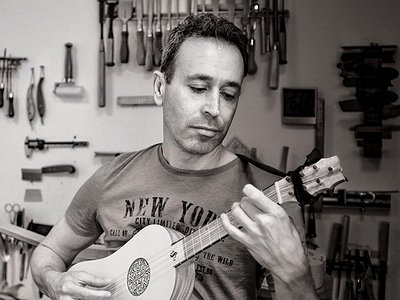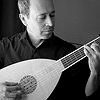Part 1
Name: Israel Golani
Occupation: Lutist, guitarist
Nationality: Israeli
Current release: Israel Golani's new single “Premier Branle d'Escosse” is available for streaming. It is taken from his forthcoming full-length album In the Garden of Polyphony on Solaire Records.
Recommendations: The Dutch word for composer is toondichter – literally translated into tone-poet. This words describes the genius of Händel – a master writing catchy melodies supported by irresistible harmonies.
Another profound toondichter is Robert Schumann. This is one of his mesmerizing songs . Christian Gehraner's voice and Gerold Huber's piano compliment each other and create a masterpiece together.
If you enjoyed this interview with Israel Golani and would like to get to know his work better, visit his official website. He is also on Facebook and runs a Youtube channel.
When did you start playing your instrument, and what or who were your early passions and influences? What was it about music and/or sound that drew you to it?
I started playing the lute at the age of 25.
From a young age I was fascinated by harmony. I remember listening (on the radio) to groups singing “close harmony” and being mesmerized by the inner voices that often created dissonances or supported interesting modulations. Pop music of the 80s is very modal (not unlike 16th century renaissance music) and I used to spend hours listening to music by The Eurythmics.
Later I fell in love with the Deutsche Lieder by Schubert, and especially by Schumann – who, again, has a very special approach to harmony and melody. The passion to be involved in music making myself led me to take lessons in vocal training and singing in a choir.
I remember walking once through an arts & crafts market in Tel-Aviv, and there was a student ensemble singing 4-voice madrigals by John Dowland. It was then and there that my devotion for renaissance music was born. Polyphonic music of the 16th century is simply beautiful. Later, when studying musicology at the Tel Aviv University these experiences led me to look for a closer relationship with this music.
As a teenager I taught myself to play the ukulele, and later the guitar, so it was not so far fetched to pick up a lute at the music academy and look for a teacher. After one and a half years of private lessons I was admitted to the Amsterdam Conservatory (then called Het Sweelinck Conservatorium).
I still play the ukulele, though, and I'm a big fan of swing music from the 1930s.
For most artists, originality is preceded by a phase of learning and, often, emulating others. What was this like for you: How would you describe your own development as an artist and the transition towards your own voice?
I can say without doubt that learning is a continuous element throughout my entire life. Singing lessons and singing in a choir has taught me linear thinking (and hearing), musicology has given me tools for analysis, as well as appreciation of different styles of music. And lute studies have naturally given me technical and musical abilities in order to play the instrument. I believe we are born with certain gifts (in my case good ears), and from there it's an ongoing process of learning - how to deploy all aspects of making music, trying to overcome challenges.
I think that my own “voice” was there all the time, but maybe not yet fully crystallized. Maybe in recent years I've had more confidence to present it. This came – yet again, together with an intensive learning period overcoming a few technical challenges, as well as a deeper analysis of lute solo music. I know for sure that this process is still ongoing.
Another aspect that supported refining my identity as a performer was collaborating with a few excellent orchestras (especially MusicAeterna with Teodor Curentzis) and performing on renowned stages around the world.
How do you feel your sense of identity influences your creativity?
As an artist I'm inspired by the beauty of things in the world, and beauty in music has an immense effect on me. I think my creativity is expressed by taking in this beauty, understanding it and presenting it back to the world through what I believe to be the most accurate rendering – striving for an “absolute”. Needless to say, this perfection is unattainable. But one can get very very close to it!
In this respect I'm much more of a classical type rather than a romantic.
Have you ever come across the Enneagram of personalities? It's a typological model of personalities – describing 9 different types of people. I've identified myself as type 5: the Observer or the Investigator. Many artists are type 5, but their art is somewhat different than artists who are identified as type 4 (the Individualist). I'd like to quote here a paragraph that describes the difference between the two types of artists. I definitely can recognize myself in this.
What were some of your main challenges when starting out as an artist and in which way have they changed over the years?
Mainly technical challenges. As a lute player one has to be able to play at least three or four different instruments for a repertoire spanning over 350 years (renaissance lute, theorbo, baroque guitar, archlute) and read different notation systems (tablature, mensural notation, basso-continuo). This takes time, persistence and discipline.
During the first 10-15 years I think it was all about learning “how to do it”. Once I arrived at a more or less stable place, the challenges were how to balance orchestral work with chamber music and solo – there's simply not enough time to do all. The emphasis now is much more on the social aspects of being a professional musician.
As creative goals and technical abilities change, so does the need for different tools of expression. Can you describe this path for you, starting from your first instrument?
Most of my creative work nowadays comes from the search for vocal expression on my instruments. Discerning the different voices (parts) on the lute is a big challenge for us, lute players. Separate voices are not visible (because of the nature of tablature; all the voices appear together on one staff) and the dynamic range is quite limited (notes are quickly either too soft or too loud – the sound breaks and the lute squeaks). We use the 4 fingers of our left hand to play polyphonic music which – seperate voices who are free and not bound.
All these limitations are quite audible on our instrument and we should address them. So I put a lot of attention in finding the correct left-hand fingering in order to maintain the continuity of each part (cantus, altus, etc'). Then I could help each vocal line to “come to life” by creating interesting phrasing for each line and looking for micro-timing between the notes. Creating this hierarchy between the notes gives these lines direction. My ultimate goal is to reach a technical prowess combined with deep musical understanding so that my lute could sing.
Tell me about your instrument, please. How would you describe the relationship with it? What are its most important qualities and how do they influence the musical results, including your own performance?
I play on 5-6 different instruments for different musical purposes. So I can't say that my relationship with these instruments is similar to lets say a violin player and his violin. This flexibility and interchangeability enables me see my instruments as tools of expression. The relationship which deepens through the years is in the area of finger-string-mind. That that's where the magic happens. You could call it the “software”.
Having said that, I'll be first to admit that the hardware is far from being unimportant. For my new recording In the Garden of Polyphony on Solaire, I have 3 great (custom-made) instruments: A 6-course lute by Martin Shepherd, a 6-course lute by Alfonso Marin, and a 4-course guitar – also by Alfonso Marin. Each instrument has a special quality that I found fitting for the recording. Originally I planned to keep only one 6-course lute and record the CD with that instrument (and the renaissance guitar), but both lutes turned up to have a unique sound and different qualities, so I decided to record on both lutes.
Collaborations can take on many forms. What role do they play in your approach and what are your preferred ways of engaging with other creatives?
When I'm not playing solo music, I usually play basso-continuo which is kind of an improvisation (apart from the bass line, my part is not written. So it's very similar to a jazz musician realizing an accompaniment upon a scheme of chords).
When I play with excellent colleagues and we're on the same wave-length, it is similar to the way children play together. It is not self-conscious and it is fun. We can come up with amazing things that would never happen when preparing the music alone at home. Spontaneous inspiration. It's not about the performance anymore – we're just playing around, reacting to each other., making music for our own sake.






